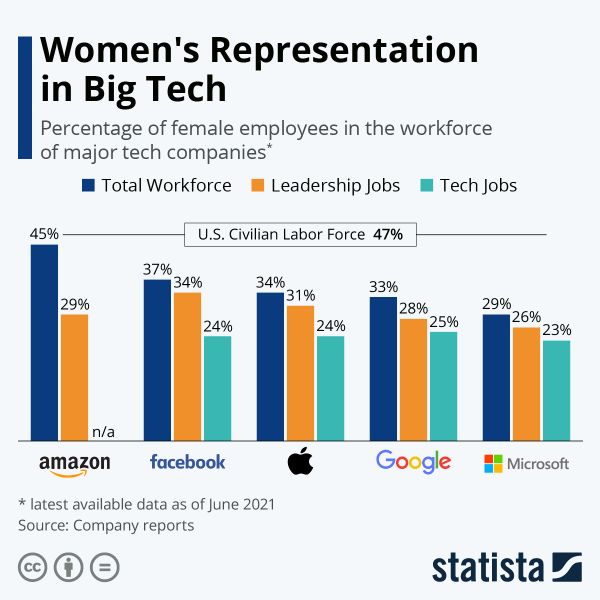Women in Technology Roundtable: Supporting the next generation
Jumar’s inaugural Women in Technology Roundtable event took place in November and focussed on supporting the next generation of women in technology. The virtual event, hosted by Jumar’s Client Services Director, Lorraine Rourke, was attended by a range of senior figures in technology from a variety of public sector organisations including NHS Digital, Homes England, the Department for Education, and the Department for Work and Pensions.
The discussion began with the current landscape of women’s roles in the technology sector. A research study by PWC of more than 2,000 A-Level and university students found that only 3% of females say a career in technology would be their first choice. It also found that 78% of students were unable to name a famous female working in technology. The discussion turned to the suggestion that if girls simply aren’t interested in technology, does that matter?
There was unanimous agreement, however that it does. With technology playing an increasingly prominent part in peoples’ lives, it is important that the demography of those designing technology is representative of the population as a whole. A strong message from the roundtable was that women should have the opportunity to shape the future through technology. The top five biggest technology companies; Apple, Amazon, Google, Microsoft and Facebook, (according to data from Statista) still significantly underrepresent females in big tech.

Why are so few girls looking to get into tech?
The group discussed a number of factors that may be discouraging females from choosing technology through school, college, university and into their careers. These included:
The curriculum isn’t wide enough – a number of attendees commented on the A level subject Computer Science not being broad enough to cover all aspects of technology including delivery, project management and user research. Technology careers are now highly creative, and the current curriculum doesn’t reflect that.
Gender gap in teaching staff – one attendee noted that there is a gender gap in teaching staff of STEM subjects. This often means that the language and analogies used when teaching these subjects tends to be more male-oriented.
Flexible working – the group discussed the need to make workplaces equal by promoting flexible working and improving work-life balance. The Covid pandemic has gone some way to achieve this. Organisations have seen the benefits of remote working and empowering employees to deliver on specific outcomes. This new flexible way of working looks set to stay and provides some optimism about more women working flexibly in technology in the future.
What are organisations doing to support the next generation?
The attendees shared some initiatives that have been implemented in their organisations including:
75% fit programme – with research showing that women tend to only apply for a job when they meet 100% of the criteria, one organisation is loosening requirements to encourage more women into technology. When recruiting for new roles, instead of only looking at candidates with 100% skills match, if candidates meet 75% of the role criteria, the organisation will invest in training/upskilling them in the additional 25%.
Success profiles – one attendee spoke about moving away from competency-based interview questions which tend to suit male candidates better. These have been replaced by a success profile framework, which assesses candidates against a range of elements to drive improvements in diversity. This includes asking candidates about how they would behave in a given situation and why they would approach a situation a certain way.
Multiple graduate schemes – one organisation breaks down its graduate scheme into individual professions including Software Development, Data Science, Product and Delivery Management, and User Centred Design. By focussing on different role types, the organisation has been able to attract a more diverse group of applicants leading to an increase in female graduate intake.
Mentoring schemes –providing junior technology team members with a more experienced mentor, can give them wider professional experience and guidance. Mentoring programmes can be invaluable in helping young women gain confidence in their careers, which the attendees agreed is one of the biggest challenges for women in the workplace.
What more can be done?
Role models –In order to attract more girls into a technology career there is a need to raise awareness of role models across all levels.
Increasing the routes into technology careers – Organisations could create alternative routes into technology careers to attract more females. Carousel apprenticeships, where the apprentice rotates through various departments of an organisation, are seen as a great way of introducing people to the variety of roles within technology and allows them to then focus on where their skillset has the strongest fit.
Summary
The roundtable attendees all agreed that much more can still be done and have set out to create a variety of case studies of both junior and senior women within their organisations to help inspire young women and provide a deeper insight into a career in technology. Jumar will also be conducting market research with local schools, further and higher education to understand how we can work together to promote technology as a great career choice for girls.
If you would like to join our next Women in Technology Roundtable or get involved in the ongoing campaigns, please get in touch with Lorraine.


